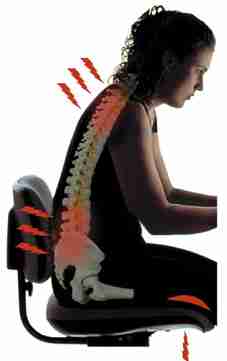PHOTO COURTESY OF WIKIMEDIA
By HEALTH MARKETS
Back pain can make daily life difficult and prevent you from taking part in activities you love. Just because it’s a common ailment doesn’t mean it has to be commonplace in your life, though. We’ve compiled advice from chiropractors – doctors specially trained to treat this kind of pain. They recommend simple changes to your everyday routine that can help relieve back pain or stop it from happening in the first place.
Back pain can result from injury, poor posture, stress, aging, strenuous work, or disease, and it affects all kinds of people. “I have more low back pain patients who sit at desks all day than are manual laborers,” chiropractor Dr. Andrew Bang told TODAY. Even everyday activities, done just the wrong way, can cause or exacerbate a bad back. Perhaps that’s why up to 31 million Americans at a time suffer from one. Just to give an idea of the prevalence of back pain, consider these facts:
• In 2015, pain in the neck and lower back was the leading global cause of disability.
• Back pain is among the top reasons why people miss work.
• A North Carolina study reported that instances of chronic, impairing lower back pain had more than doubled over a 14-year period.
• Eight out of every 10 people will suffer from back pain at some point in their lives.
Don’t be a statistic. Take advantage of the chiropractor tips below to put a stop to back pain or make sure it doesn’t happen to you.
1. Make time to get active. A healthy weight, healthy diet, and regular exercise go a long way toward warding off back pain. Exercise helps strengthen the muscles in your back, and regular activity can relieve back pain that can accompany sitting too long. Whether you’re working out or doing other physical activity, such as chores, make sure to warm up before you start and do a quick cool-down afterward. During long periods when you’ll be seated, make sure to take the time to get up and stretch at regular intervals. A 2015 study in the Clinical Journal of the American Society of Nephrology showed people who spent 2 minutes per hour performing light physical activity, such as walking, had a 33 percent lower death rate over the course of the study.
2. Set up your office and car to be pain-free. An optimal work area will encourage good posture while you sit and allow you to work without straining yourself into uncomfortable positions. Screens you use, such as computer monitors or cash registers, should be at eye level and face squarely toward you. The same goes for driving.
Make your commute comfortable with some small adjustments. Move the driver’s seat close enough to the gas pedals that your back still touches the chair when you reach for them. A lumbar pillow can provide extra support if back pain while driving is a common issue for you.
When you drive, keep the back of your head against the headrest and your chin up to offset the day’s tension.
3. Remain mindful of posture when sitting and standing. Now that your office and car are in order, make sure you have proper posture to match. When you’re seated, don’t cross your legs. Instead, place your feet flat on the floor, straighten your shoulders and back, and keep your head up. If your setup (or your genetics) prevent your feet from touching the floor, place a box or other footrest under them for support. In a standing position, keep your back straight, stomach tucked in, and rest your weight on the balls of your feet. Bend, don’t lock, your knees.
If you must be on your feet for long periods, use a stool or other rest to raise one foot 4-6 inches and take pressure off your spine.
4. Get a good night’s rest that’s good for your back. Sleeping on your side or your back is best. Chiropractors don’t recommend resting on your stomach, which forces you to strain your neck to one side or the other. On your back, place a pillow under your knees, and if you sleep on your side, separate your knees with a pillow. These positions support the natural curve of your spine. Use a mattress with a moderate amount of firmness, and avoid using soft mattresses or sleeping somewhere other than your bed. Prop your head with one pillow, and aim for keeping your spine level through your neck and back. Your shoulders and back will be on the mattress, with the pillow underneath your head and neck.
5. Be smart with your smartphone. Next time you’re in a crowd of people waiting for something—in line at a concert or seated in a movie theater waiting for previews to look around and take note. You’ll see lots of smartphones out, and the people who use them are more often than not holding the phone in their laps, hunched over the devices with their necks craning down. The human head weighs about 12-15 pounds, Dr. Bang explained to TODAY. Dangling that weight from your head and down at your smartphone risks straining your neck muscles and putting pressure on bones and discs. Instead, keep the screen at eye level and use your eyes, not your neck, to adjust your gaze.
When using your phone to make a call, don’t pull your neck over to prop the device between your ear and shoulder. Hold the phone with your hands, or set up a hands-free talking system such as a speakerphone or headset.
There’s no reason to accept back pain as just a part of life. As you can see, most of the chiropractor tips are small changes to your daily routine that don’t cost a thing. Why not try their advice today?










No Comment